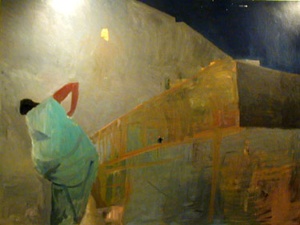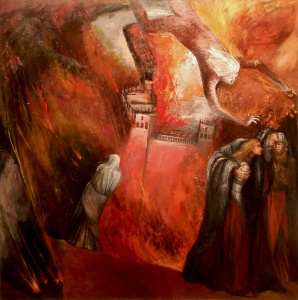The Biblical Painters Journey
Come on a journey with me, to a time when four artists were young, idealistic and filled with a passion to remake their world and create a new vision in response to a sterile and empty art world. It was the mid-70s, the vibrancy of abstract expressionism was long gone and the art world was cranking out smaller and shorter “movements” one after another with less visual interest and more intellectual cynicism. Painting was declared dead and media glitz was offered as an answer to our cultural malaise. A small group of artists in downtown Manhattan declared that it was still possible to do meaningful figurative painting and out of that group these four choose the subject matter of the Bible as their banner.
I was one of them, along with John Bradford, Tony Siani, and Jack Silberman and the current show of the Biblical Painters Group at 55 Mercer Gallery is a retrospective of 25 years of work that we have done using Tanach as our subject matter. Tony Siani passed away five years ago and this show is dedicated to our friendship and his memory. Each artist has six major paintings that in total depict 24 different passages from the Torah, the Prophets and the Writings. The textual references have been provided at the gallery.
I remember the all night discussions at Siani’s downtown loft that hammered out, with the help of our good friends political writer Tom Milstein and Rabbi Avi Berkowitz (currently at Ramaz), the foundations of our approach to the Torah as the defining document of Western civilization. We became convinced that one of the central ideas that “drove” the West was Monotheism and its people, the Jews. The Torah that epitomized community and the growth of a people in relationship to God was a radical answer to the “me” generation and the emptiness of the culture of the past 25 years.
Two non-Jews and two Jews discover the Torah. For Bradford and Siani their vision was to use this powerful tool to reassess the complexity of social relationships in the light of the Divine. Effectively they become Noahites. Silberman, a master watercolorist, flourished as he explored complex familial struggles in the narratives of David and Solomon. And I found the subject matter I had always been looking for and, finally, the belief and Orthodox observance I never knew I lacked.

I remember Tony Siani working in his vast Walker Street loft on the Calling of Isaac (reproduced here) year after year, struggling to arrive at a “fully realized” vision of Genesis 22:2-4. Underlying the incredible test of Abraham was the shared trust and faith between father and son that Siani was determined to embody in beautiful color, traditional form and drawing. Each nuance of light and color, the delicate flowers that echo the parent-child relationship and the harsh rocks that hover over Abraham were arrived at after years of consideration and reconsideration of painting and subject. The radically modernist Akeidah by Siani diagonally across the gallery is witness to the fact that each of these artists has done many versions of the subjects you see here. These artists have worked in the understanding that there is no one singular understanding of any verse in the Torah.
I can still feel the awe I first felt seeing Jack Silberman’s Life of King David Triptych as it was painted in his apartment on upper Broadway. It overwhelmed the space with its inventive color and fresh vision of David and Goliath (the hulking bully); The Vision of David swaying in rapture with the golden City of Jerusalem and Book of Psalms and; finally, the stark tragedy of David and Absalom. Each painting is an essay in Modernism harnessed to the Biblical narrative.

Bradford’s Esther, Ahasuerus and Haman is a masterful tableaux of Esther’s final feast that arrives at the tense moment of “Who is this…” with the dread of an as yet unknown conclusion. The largest painting in the show (9’ x 12’) is his powerful David and Bathsheba. Bathsheba looms in the foreground with her back to us as we visually jump to a tiny David set in the middle ground, pausing at the walls of an enormous city and a Temple Mount that dominates the entire canvas. The choice between the sacred city and David’s desire is palpable.

McBee’s Sodom seethes with fire and brimstone as Lot and his daughters are squeezed in the dilemma of exile and incest at the edge of this 8’ x 8’ canvas. His Moses Teaching the Law is a contrast in bright colors and collage expressing the diversity of the Jewish people as they construct a world from the Law and their own experiences.
Perhaps the most startling insight of this show is the realization that our encounter with the Torah has sustained our artistic creativity for a quarter of a century. There were many other artistic paths that could have taken and yet the Biblical narrative drives all the paintings shown here, constantly innovating with color, scale, multiple canvases and mixed mediums to arrive at startling interpretations of the text. In terms of artistic creativity alone we were right in choosing the Torah. Each artist here stands as a type of “baal teshuvah” and to encounter these art works with the text of Tanach in hand is to truly stand in that special place.
The Biblical Painters Group: Works from the 1970s to the Present: John Bradford, Richard McBee, Tony Siani, and Jack Silberman
55 Mercer Gallery, 55 Mercer Street, New York, NY 10013